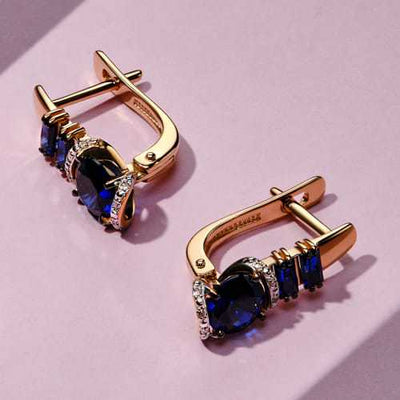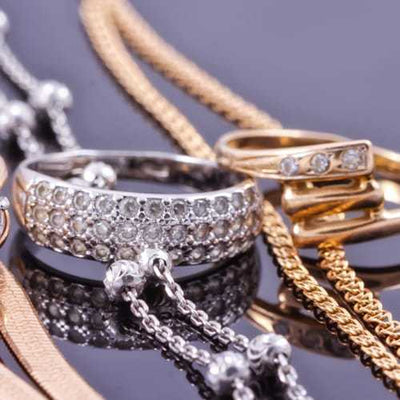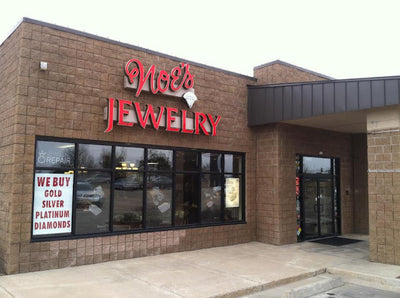Buying a watch can be a very overwhelming experience. There are seemingly endless options to choose from at a variety of prices ranging from less than $20 to hundreds of thousands of dollars. Watches are purchased both for their functionality and beauty. Often, they are worn as jewelry. If you are new to watches or are in a watch-buying rut, Noe’s Jewelry has this handy guide for purchasing a watch.
We’ll discuss:
- Watch Anatomy
- Watch Movements
- Complications
- Band Types
- Watch Styles
- Watch Sizes
- Watch Prices
Watch Anatomy
Watches are complicated pieces of technology. There are several parts of a watch, and each of them has its own function. Let’s take a look at the anatomy of a watch.
Aperture: A small window in the dial that displays complication information such as the date, month, or moon-phase.
Bezel: The metal ring around the crystal or glass piece of the watch that holds the clear piece in place.
Case: The container that houses and protects the watch movement. Cases can be round, square, rectangular, and a variety of other shapes.
Crown: The button (or buttons) on the outside of the case that is used to set the time and calendar. In mechanical watches, the crown is also used to wind the mainspring.
Crystal: The transparent cover that protects the dial of the watch and minimizes glare. The crystal can be made from glass, plastic, or synthetic sapphire.
Dial: The plate with a metal base that is visible through the crystal. The dial displays the time.
Hand: These are the small pieces that move over the dial to indicate the hour, minute, or second. Usually, watches have three hands to show all of those levels of time.
Jewel: Small jewels, such as sapphires or rubies, are located on the movement to reduce friction by acting as bearings for the gears in a mechanical watch.
Lug: Located on the watch case, lugs are where the straps are connected to the rest of the watch.
Movement: The inner mechanism that allows a watch to keep time.
Pusher: Button or buttons located on the outside of the case to control certain functions of a watch. They are commonly found on watches with a chronograph.
Rotor: The rotating piece that winds the mainspring to store power in automatic watches.
Strap/Bracelet: The material that holds a watch onto a person’s wrist. Straps are non-metal materials, while bracelets are the metal counterparts.
Subdial: A small dial inside the main dial of the watch to give additional information. A chronograph is a great example of a subdial.
The jewel, movement, and rotor are all located inside of the watch, so they aren’t pictured in the above diagram.
Watch Movements
One of the more complicated factors surrounding watches is the movement. Movement refers to the sweep of the hands of the watch around the face and the way the internal parts produce that effect. The movement is fundamental in how the watch works and keeps time. There are three different types of movements:Mechanical
In a mechanical watch, the movement is powered by a mainspring made of coiled metal wire that is wound by hand. Once the mainspring has been wound, it will slowly and evenly unwind, which causes the second hand to move in a smooth motion around the face of the watch. In general, the mainsprings are between nine and 13 inches long, and the longer they are, the longer the watch’s power reserve. The longer the mainspring, the longer you can go between windings.
For some, mechanical movement watches are the most desirable due to the engineering that goes into making them. They are also considered desirable due to the historic factor. Mechanical watches don’t need batteries, but they will need to be wound regularly to properly keep the time. Additionally, mechanical watches tend to be more sensitive to moisture, dust, magnets, and other external factors.
As the watch ages, it will also start to keep time less accurately, and you will need to take it into a jeweler every five to ten years for a tune-up. Mechanical watches also tend to be more expensive than other watch types.
Automatic
Automatic watches work much like mechanical watches. They are powered by a mainspring, but they don’t need to be wound like mechanical watches. Instead, your movement while wearing the watch winds the mainspring. These watches are often called self-winding watches. While you are wearing the watch, your movement causes a small weight called a rotor to wind the mainspring. These watches also contain a slipping clutch device that prevents over-winding.
When you aren’t wearing an automatic watch, you should use a watch winder to make sure that the time stays accurate while you store it. Much like mechanical watches, these watches can be affected by external factors like watch and dust, but they tend to be less accurate.
Quartz
Quartz watches are known for their incredible accuracy and affordability. Quartz movement watches are powered by a small battery instead of a mainspring. The battery sends electricity through a small quartz crystal. The crystal vibrates tens of thousands of times per second, and the vibrations are converted into a pulse that moves the second hand of the watch.
With quartz watches, you can hear the ticking movement of the hand, which isn’t going to be as smooth as the other types of movements. These watches tend to be more accurate and durable than mechanical and automatic watches. The battery in a quartz watch will need to be changed occasionally, but these watches rarely have time-keeping problems.
Complications
While the main function of a watch is to tell the time, many watches also have other special features. These special features are called complications. One of the most common complications is the calendar. Many watches display the date in some form or another.
Another common complication is the chronograph. The chronograph is a separate time system that is used as a stopwatch. Often, chronographs consist of three small dials within the main dial of the watch. Along the side of the watch, there will be a couple of buttons. One button will start and stop the chronograph, and the other is responsible for resetting the chronograph. On some watches, chronographs are paired with tachymeters, which are scales inscribed around the rim of the watches. Using these two things together can allow you to calculate things like speed and distance traveled.
Other complications include moon phase displays, alarms, and power reserve indicators.
Dressy watches tend to have zero or only one complication. In these watches, usually, the date display is the only complication. Sporty and casual watches may have a variety of complications.
Band Types
 When you are considering a new watch, you aren’t just thinking about the face of the timepiece. You also need to consider the material of the strap. There are four main strap materials to choose from. The first is metal. Metal bands, also called bracelets, provide a masculine look. Watches with metal bracelets are incredibly versatile and can be worn in both formal and informal settings.
When you are considering a new watch, you aren’t just thinking about the face of the timepiece. You also need to consider the material of the strap. There are four main strap materials to choose from. The first is metal. Metal bands, also called bracelets, provide a masculine look. Watches with metal bracelets are incredibly versatile and can be worn in both formal and informal settings.
Leather straps are a great option for dressy watches. This material provides a classic, timeless look. Leather bands are slim and sleek, and they are the most formal of the watch band types. However, leather watches can be hot, and they can be damaged by sweat.
Canvas bands, which are often referred to as NATO straps, are a great option for a less formal watch band. NATO straps are different from other types of bands because they are made of only one piece of material. To attach a NATO strap to a watch, you need to remove both of the spring bars on the watch, and then you can weave the strap under the spring bars. These bands are often very inexpensive, which makes them desirable to some.
Rubber straps are often considered very casual, but depending on their appearance, they can be worn with more formal ensembles. A rubber, or resin, strap doesn’t necessarily mean that a watch is cheap or of poor quality, but it does show that it was made to be more functional. Watches with rubber straps aren’t going to be considered jewelry like some of the other options.
Within each of these major band types, there are subtypes. These subtypes are often determined by small differences in the style of the band.
Watch Styles
While there are a wide variety of different types of watches, there are only five types of stylish men’s wristwatches. Here’s a little look at each one.Dress Watches
Dress watches first came about in the early 20th century for those gentlemen who wanted to wear wristwatches instead of carrying around a pocket watch. These watches are all about simplicity and sophistication. Often, these watches are subtle and classy.
Dress watches are usually thin so that they can easily slip in and out of the cuff of a dress shirt. The case of the watch can be square, circular, or rectangular. High-end dress watches are usually made of either silver or gold. Bands on these watches are leather, and on the face, dial displays are simple with numbers, Roman numerals, or saber-style indexes. Usually, there are few or no complications on dress watches. Usually, you will only see the date and/or moon display.
These watches are worn for formal occasions. When you would wear a business suit or tuxedo, these are the type of watches you should consider. You can also wear these with anything down to sharp casual clothing.
Field Watches
Field watches are direct descendants of “trench watches” that were used in WWI. The original watches were designed for officers who needed to know the time to coordinate attacks, so the watch needed to be able to display the time at night and hold up to the conditions of battle. Field watches are rugged and functional, while still being stylish.
Since a large watch would get in the way during combat, field watches tend to be small to medium in size. The face needs to be easy to read, which is why most field watches features a white dial with black numbering or the reverse. The hands also usually illuminate so that the watch can be read when it is dark.
The cases of field watches need to be durable, so they are often stainless steel or titanium. Additionally, field watches may have a feature called “hacking seconds.” This feature allows you to pull the crown out to stop the second hand so that you can easily set the watch to a reference signal or synchronize it with another watch. Field watch bands are usually leather or canvas as metal is too heavy and easy to scratch. The only complication that is typically found on a field watch is the date, and even that is rare.
Field watches are considered casual to business casual. Those who rarely get dressed up may prefer the simple, rugged style of field watches.
Diving Watches
Diving watches are extremely popular, which might be attributed to the fact that James Bond is a frequent dive watch wearer. These watches were designed to be worn by people who spend a lot of time in or near the water. They are water-resistant due to their hermetically sealed cases. Most diving watches are water-resistant up to 100m, but many are made to keep working at even deeper depths.
Diving watches are usually medium-sized with bold, easy-to-read Arabic numbering on the face. These watches are typically made with sapphire or hardened mineral glass to protect the face of the watch underwater.
On the case, there is generally a uni-directional bezel that will only rotate counter-clockwise. This bezel allows the diver to see how long he’s been underwater. To use the bezel, a diver rotates the “0” to line up with the minute-hand of the watch when he enters the water. When the diver goes to check how long he has been in the water, he just looks at the marking on the bezel that the minute hand is pointing to. The only complication usually found on these watches is the date.
Bands on diving watches are usually metal. They are also made longer than the after band because they were designed to fit over diving equipment. The deployant clasp used on divers’ watches often includes what is called a divers’ extension to make the watch large enough to go over any equipment worn by a diver.
While these watches were created to be used underwater, they are perfect for everyday wear. Diving watches can be worn with casual wear, business casual wear, and business formal wear.
Aviator Watches
Aviator watches, which are also called pilot watches, were created to make timekeeping as easy as possible for pilots. Unlike many of the other styles of watches, aviator watches don’t have a distinctive style. Even the features vary from watch to watch. However, some of the most common features for aviator watches include medium to large size, faces designed for easy reading, luminous hands, clean design, and complications of only the date and possibly a chronograph. Often, bands are made out of leather—although they can be metal. Bands also tend to be longer than average, because they were originally designed to fit around the cuff of a pilot’s jacket.
Aviator watches tend to look very casual. While they can be worn in casual settings, they would not be suitable for business wear or black tie.
Racing Watches
Racing, or driving, watches were creating for car racing, because drivers rely on accurate timekeeping to measure the outcome of the races they perform in. The distinguishing features of driving watches are the chronograph and tachymeter. These two complications are used to measure the speed and distance racers go during the race.
Driving watches tend to be medium to large in size with a large dial that leaves enough room for the chronograph. Racing watches use Arabic numerals in contrasting colors to make it easy for drivers to see the times with just a glance. The cases on these watches tend to be made from stainless steel with either a leather or metal band.
These watches tend to be a bit fancier than diving and aviator watches, but they are still more on the casual side.
Watch Sizes
Another important factor to consider when choosing a watch is the size. You will want to see how a watch looks in proportion to your wrist. A watch that is too large will look garish, while a watch that is too small will look tiny and feminine. A good rule to follow is if the circumference of your wrist is between six and seven inches, you should look for a watch with a case diameter between 38 and 42mm. If your wrist is larger than seven inches, then you will want to look for a watch with a case diameter between 44 and 46mm. The average men's watch size is between 37 and 39 mm.
You can also try watches on to see how they look. It might be a good idea to get the opinions of others as well because you want to get a good watch size for your wrist.
Watch Prices
As we’ve previously mentioned, there are watches at almost every price point. For this reason, many people wonder if the hefty price tag of luxury watches is worth it. While for some people, the expensive watches are worth every penny; for others, the price is a huge drawback. It is also important to remember that there are two classes of luxury watches.
First, we have mass-market luxury watches. These are the watches that are only expensive due to marketing. Rarity isn’t a factor in these timepieces, but they are generally made from precious metals, which does increase the value of the watch. Typically, they also use higher quality glass or sapphire to cover the face of the watch as well. Mass-market luxury watches are designed to work better and last longer than less expensive watches. You will get a watch with a better build and movement, but you are also paying for the name of the brand.
Then we have true luxury watches. These are the watches that cost tens of thousands of dollars or more. In fact, some are even in the hundreds of thousands of dollars. Unlike mass-market luxury watches, these watches really are rare. Usually, only a few hundred of these watches are made. This is the case because many of them are handcrafted with the finest materials available. In some cases, these watches can take months and even years to complete.
There is nobody else who can determine if the price of a watch is worth it to you. You need to weigh in your desires and budget to decide how much you want to spend on a timepiece. For more help purchasing a watch, visit Noe's Jewelry today in Raymore, Missouri.





